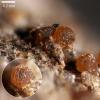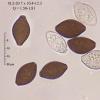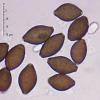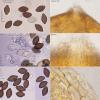
28-12-2025 12:08
Margot en Geert VullingsThis possible Karstenia was found on the bark of d

21-12-2025 21:32
Pol DebaenstHello, Garden, Burgweg 19, Veurne, BelgiumOn 10/1

26-12-2025 21:19
Arnold BüschlenPithyella chalaudii Priou. Ist als Bryoparasit in

21-12-2025 09:32
Hello.A tiny ascomycete found embedded in wood in

18-12-2025 21:17
Pol DebaenstThe identification took me to Byssonectria deformi

24-12-2025 17:08
Hulda Caroline HolteHello, I have found this propoloid ascomycete on
These small (0.3-0.4 mm) orange perithecia grew on incubated rabitt dung for one month. They seem to be ostiolate because there is a crown of hyaline setae around the very inconspicuous, not protruding, neck. Perithecial walls are more o less glabrous. Asci clavate. Ascospores citriform, biporate with smooth walls.
According to GARCIA & al. (STUDIES IN MYCOLOGY 50: 63–68. 2004) the genus Sphaerodes currently comprise species characterized by non-ostiolate ascomata (if they are ostiolate they have a short neck surrounded by a crown of hyaline setae) and reticulate ascospores, umbonate at both ends. So only rest Melanospora as a good choice for my fungus. But I don't know a keyed species that matches with this collection.
Could you help me?
Thanks in advance

Good harvest! Your photos on the neck seems short and with this size can be spores can you look to M.fimbriata?
Michel.
Hi Michel
M. fimbriata is poorly described by Petch (Trans. Brit. Mycol. Soc.) with ELLIPSOID (sic) ascospores. And the somewhat platanoid, not really citriform ascospores drawn by Cannon & Hawksworth (pag. 126) together with the very small perithecia (40-50 microns in diam.) I think don't agree with my collection.
Thanks a lot



